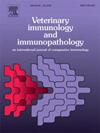梯度隔离是否能保持马中性粒细胞活力和氧化功能长达6小时?
IF 1.4
3区 农林科学
Q4 IMMUNOLOGY
引用次数: 0
摘要
本研究研究了马中性粒细胞的分离,并采用硝基蓝四氮唑(NBT)还原试验评估其抗氧化功能,硝基蓝四氮唑是活性氧(ROS)激活的指标。目的是测试从马全血中分离的中性粒细胞的生存能力及其呼吸爆发的能力,并将结果与全血进行比较。经检验的假设是,马中性粒细胞的分离允许有效的功能评估,即使在分离过程之后,全血和分离细胞之间没有显着差异。研究表明,中性粒细胞在6小时内保持其减少NBT染料的能力,在分析的时间点(0 h, 3 h和6 h)之间没有显着差异。使用Histopaque®进行分离,在三个不同的时间点评估总中性粒细胞浓度和氧化功能。使用自动和手动技术进行细胞计数和活力评估,确认中性粒细胞的延长活力和抗氧化功能测试的准确性。本文章由计算机程序翻译,如有差异,请以英文原文为准。
Does gradient isolation preserve equine neutrophil viability and oxidative function for up to six hours?
This study investigated isolation of equine neutrophils and the assessment of their antioxidant function using the nitroblue tetrazolium (NBT) reduction test, an indicator of reactive oxygen species (ROS) activation. The objective was to test the viability of neutrophils isolated from equine whole blood and their ability to undergo respiratory burst, comparing the results with whole blood. The hypothesis tested was that isolation of equine neutrophils allows for effective functional evaluation, even after isolation process, with no significant differences between whole blood and isolated cells. The study showed that neutrophils maintained their ability to reduce NBT dye over a 6-hour period, with no significant differences between time points analyzed (0 h, 3 h, and 6 h). Isolation was performed using Histopaque®, and total neutrophil concentration and oxidative function were evaluated at three different time points. Cell counts and viability assessments were conducted using both automated and manual techniques, confirming the prolonged viability of neutrophils and the accuracy of antioxidant function testing.
求助全文
通过发布文献求助,成功后即可免费获取论文全文。
去求助
来源期刊
CiteScore
3.40
自引率
5.60%
发文量
79
审稿时长
70 days
期刊介绍:
The journal reports basic, comparative and clinical immunology as they pertain to the animal species designated here: livestock, poultry, and fish species that are major food animals and companion animals such as cats, dogs, horses and camels, and wildlife species that act as reservoirs for food, companion or human infectious diseases, or as models for human disease.
Rodent models of infectious diseases that are of importance in the animal species indicated above,when the disease requires a level of containment that is not readily available for larger animal experimentation (ABSL3), will be considered. Papers on rabbits, lizards, guinea pigs, badgers, armadillos, elephants, antelope, and buffalo will be reviewed if the research advances our fundamental understanding of immunology, or if they act as a reservoir of infectious disease for the primary animal species designated above, or for humans. Manuscripts employing other species will be reviewed if justified as fitting into the categories above.
The following topics are appropriate: biology of cells and mechanisms of the immune system, immunochemistry, immunodeficiencies, immunodiagnosis, immunogenetics, immunopathology, immunology of infectious disease and tumors, immunoprophylaxis including vaccine development and delivery, immunological aspects of pregnancy including passive immunity, autoimmuity, neuroimmunology, and transplanatation immunology. Manuscripts that describe new genes and development of tools such as monoclonal antibodies are also of interest when part of a larger biological study. Studies employing extracts or constituents (plant extracts, feed additives or microbiome) must be sufficiently defined to be reproduced in other laboratories and also provide evidence for possible mechanisms and not simply show an effect on the immune system.

 求助内容:
求助内容: 应助结果提醒方式:
应助结果提醒方式:


